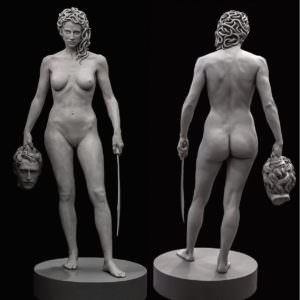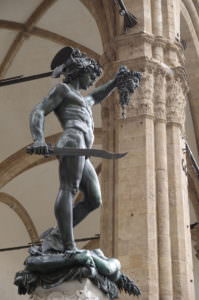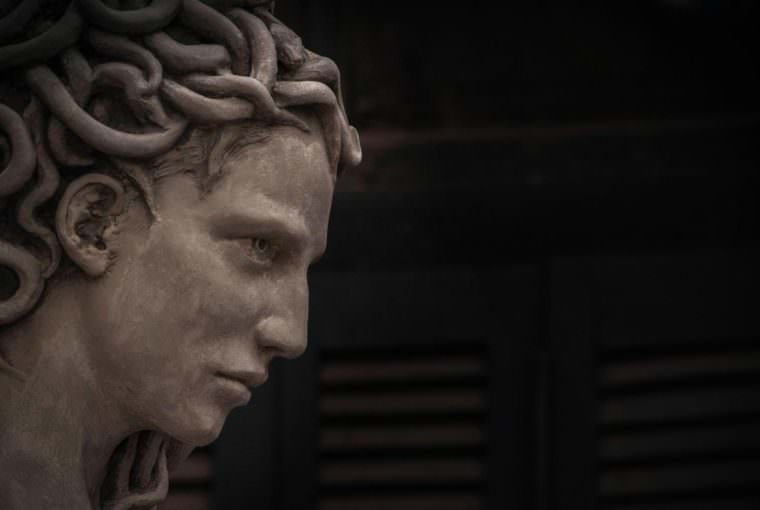“Medusa With The Head of Perseus” was installed on Monday and unveiled the following day in a park across from Manhattan Supreme Court, according to the group behind the statue. “The place chosen is not accidental, since there they judge cases for crimes related to violence against women,” said Sculptor Luciano Garbati. The 1,000-pound bronze sculpture is a reimagined version of Medusa, a figure of ancient Greek mythology who was raped by one of the most powerful gods, Poseidon. But instead of Poseidon being punished, Medusa was blamed and transformed into a monstrous beast with snakes for hair, as well as a gaze that could turn men into stone.
Well, she’s back in the news again.
Maybe you’ve seen her in your social media feed. A woman in the midst of an unsavory, unrequested task, she stands naked, her hair a tangle of serpents, a sword in one hand, a severed head in the other. Her gaze is not triumphant, exactly, but resolute.
This vision of a re-imagined Medusa myth is a sculpture by Luciano Garbati, a 45-year-old Argentine-Italian artist based in Buenos Aires who has watched in amazement lately as a piece of art he made in 2008 has gone viral across social media, as the perfect avatar for a moment of female rage.

The original Greek myth of Medusa offers plenty to be angry about. The monstrous being with snakes for hair starts out as a human woman, who Poseidon rapes in Athena’s temple. The goddess then punishes Medusa by turning her into a Gorgon and exiling her. Perseus is later sent on an errand to bring Medusa’s head to King Polydectes. Equipped with a mirrored shield, winged sandals, and a special sack for her head, Perseus creeps up on Medusa while she lies sleeping, cuts off her head, and then uses it as a weapon for turning enemies into stone.
Garbati came to question the characterization of Medusa as a monster, pointing out that she was “raped and cursed and killed.” As a child, Garbati lived in Italy, in a small town near Florence, where Cellini’s famous Perseus with the Head of Medusa stature sits in the Piazza della Signoria and Caravaggio’s painting of Medusa hangs in the Uffitzi Gallery.
“Cellini’s work really astonished me, from my childhood,” he told me in a phone interview from Buenos Aires, where he sculpts original pieces, does production work for other artists, and works as an art hanger and installer. “There are lots of depictions of Medusa, and they are always describing the myth at its worst,” he said.
As an artist, he became fascinated with one question: “What would it look like, her victory, not his? How should that sculpture look?”
https://www.instagram.com/p/B8pxG6yAfR1/
Before the attention on social media, Garbati’s Medusa had been lingering in relative obscurity. Though he sculpted her in clay, then cast her in resin with fiberglass reinforcement a decade ago, the work has only been in one show, and remains in his studio in Buenos Aires, available for sale in the original resin for $35,000, or in bronze for approximately $25,000 more, depending on the foundry. Standing at more than two meters tall, she’s larger than life, even more outsized than her social media presence.
“I was thinking of Perseus, this man with all his gadgets, going there and having this victory,” said Garbati. “This difference between a masculine victory and a feminine one, that was central to my work. The representations of Perseus, he’s always showing the fact that he won, showing the head…if you look at my Medusas…she is determined, she had to do what she did because she was defending herself. It’s quite a tragic moment.”

Perseus with the Head of Medusa by Benvenuto Cellini
Garbati posted photos of the sculpture to his Facebook page earlier this year. He immediately noticed friends, then friends of friends, and then people he didn’t know at all, using the image to illustrate their reactions to the news, or as a profile photo. An Italian writer named Sara Giovinazzi published a blog post that used his sculpture to reflect on the idea of mythological inversions, spread the image even further.
When Medusa started popping up all over social media, on Reddit, Twitter, and Instagram, Garbati joined Twitter to gently remind fans that he was the artist behind the work, and that the sculpture was not, as some had reported, in Florence, Italy, but in his studio in Argentina.
Garbati says he has appreciated finding a new audience for an older work, but what was really gratifying and striking to him were the messages about Medusa and his version of the story. “People from all over world started messaging me, telling me that they were fascinated with the sculpture and thanking me,” he said. “What? You don’t have to thank me. I’m thanking you because of this message. It’s beautiful to receive those words.”
With support from the NYC Parks Department, the statue will be on view for six months. “My hope is that when people walk out of the courthouse, they will connect with [the statue] and they will have either have accomplished a comfortable sense of justice of themselves or feel empowered to continue to fight for equality for those being prosecuted.”
Article credits NYPost.com and The Quartz



